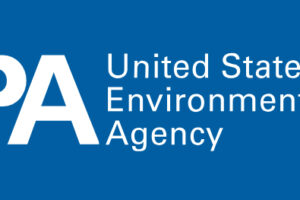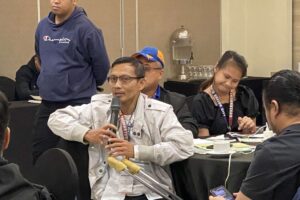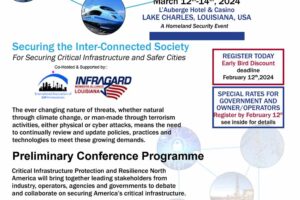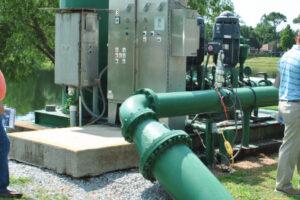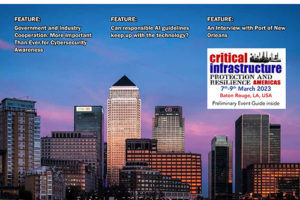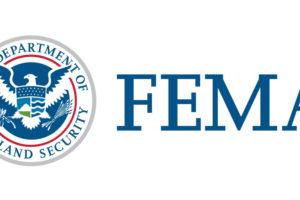Weather Ready Pacific charts the way on Early Warnings for All
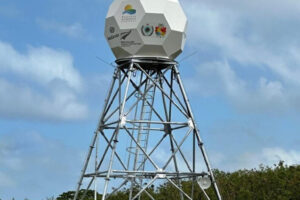
Weather Ready Pacific - a major ten-year programme – aims at reducing the human and economic cost of severe weather events, protecting Pacific Island communities and livelihoods on the frontline of climate change.
WMO Deputy Secretary-General Ko Barrett stressed WMO’s commitment to the initiative in a high-level event at COO29 on “Early Warnings For All in the Pacific: Starting our journey to navigate through the challenges of a climate change world.”
Ministers and their representatives from Tonga, Fiji and Samoa highlighted the importance of the programme in building resilience to hazards such as tropical cyclones and coastal inundation in an era of rising sea levels and more extreme events.
Tiofilusi Tiuete, Minister for Finance and National Planning of Tonga, said there were already tangible improvements in forecasts thanks to a new weather radar which will increase the accuracy of advance warnings of high-impact events.
The Weather Ready Pacific Program was developed with the support of the Secretariat of the Pacific Regional Environment Programme (SPREP), WMO and the Government of Australia through the Australian Bureau of Meteorology (BOM). It is administered by SPREP and has a target to raise US $ 191 million over 10 years to strengthen the capacity of National Meteorological and Hydrological Services in the Pacific.
“We are committed to supporting sustainable capacity enhancement efforts wherever they occur and we stand ready to support with technical tools and guidance. National Meteorological and Hydrological Services are at the centre of all these efforts,” Ko Barrett told the high-level event.
“We are happy to leverage funding through the Systematic Observations Financing Facility (SOFF) and the Climate Risk and Early Warning Systems Initiative (CREWS) and other investment instruments to support the aims of the Weather Ready Pacific Programme and more generally of the Early Warnings for All initiative.”
Climate change ambassadors from Australia and New Zealand, two of the main financial backers, stressed how the programme is intended to foster long-term investment in sustainability. The aim is to bring different funding initiatives from a variety of partners under one roof and within a 10-year time frame, thus easing the administrative burden on Small Island Developing States.
“We have had so many projects that stop and start, stop and start. We spent more time writing reports than we do forecasting the weather,” said ‘Ofa Fa’ Anunu, the coordinator of the Weather Ready Pacific Programme. He was formerly the head of Tonga’s NMHS and president of WMO’s Regional Association for Asia-Pacific.
Systematic Observation Financing Facility (SOFF)
The Pacific represents 15 % of the world surface, but it has only six upper air stations which are compliant with the Global Basic Observing Network. This is a major gap that needs to be filled, given that a chain is only as strong as its weakest link.
SOFF seeks to fill this gap through long-term, grant based investments in infrastructure and enhancing the capacity of National Meteorological and Hydrological Services (NMHS).
Within the Pacific, Kiribati and the Solomon Islands have been approved for an amount of USD 20 million. Nauru and Samoa have been provisionally approved for an amount of USD 12 million.
Climate Risk and Early Warning Systems Initiative
Climate Risk and Early Warning Systems initiative seeks to bridge the early warnings capacity gap. Ko Barrett said CREWS is a textbook example of people-centred, community-based projects that are making a tangible difference to people’s lives.
WRP and CREWS share common programming frame and principles of country/regional driven programmes, people-centered approaches, and gender-responsiveness, said Gerard Howe, Head of Energy, Climate and Environment Directorate, UK Foreign, Commonwealth and Development Office (FCDO) and Chair of CREWS.
“CREWS is committed to support Weather Ready Pacific as a vehicle for more effective programming and financing,” he said.
Pacific Island countries benefited from one of the very first CREWS financing decisions in 2017. The CREWS Steering Committee recently initiated the consultations for a third phase of this regional project bringing the total contribution to the region to USD 25 million.
In Papua New Guinea, with the support of the Australian meteorological services, a new drought early warning system was established. In PNG, nearly eight in ten people rely on subsistence farming. Food insecurity is mostly due to crop failures from drought and frost.
Support to develop similar drought advisories has been received from 5 additional Island States and an additional US$ 5 million committed to support these.
Two countries (Tonga and Vanuatu) have accessed financing through the CREWS Accelerated Support Window a fast-track provider of technical assistance. This has led to the development of a smart weather app.


